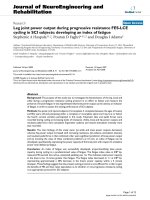index of cnpmpth02004thamkhao
Bạn đang xem bản rút gọn của tài liệu. Xem và tải ngay bản đầy đủ của tài liệu tại đây (895.2 KB, 31 trang )
<span class='text_page_counter'>(1)</span><div class='page_container' data-page=1>
<b>Bonus Topic:</b>
<b>Priority Queue</b>
The Priority Queue
• We call it a priority
<i>queue</i>
- but its not FIFO
• Items in queue have PRIORITY
• Elements are removed from priority queue in either
increasing or decreasing priority
– Min Priority Queue
– Max Priority Queue
</div>
<span class='text_page_counter'>(2)</span><div class='page_container' data-page=2>
The Priority Queue
• Consider situation where we have a computer
whose services we are selling
• Users need different amounts of time
• Maximise earnings by
min priority queue
of users
– i.e. when machine becomes free, the user who needs
least time gets the machine; the average delay is
minimised
P=2 P=5 P=1 <sub>P=25</sub> P=9
Next user chosen will be
The Priority Queue
• Consider situation where users are willing to pay
more to secure access - they are in effect bidding
against each other
• Maximise earnings by
max priority queue
of users
– i.e. when machine becomes free, the user who is willing to
pay most gets the machine
P=2 P=5 <sub>P=1</sub> <sub>P=25</sub> <sub>P=9</sub>
</div>
<span class='text_page_counter'>(3)</span><div class='page_container' data-page=3>
The Priority Queue
• Common data structure in computer
science
• Responsible for scheduling jobs
– Unix (linux) can allocate processes a priority
– Time allocated to process is based on priority
of job
• Priority of jobs in print scheduler
Priority Queue
<b>Priority Queue</b>
• The elements in a stack or a FIFO queue are ordered
based on the sequence in which they have been inserted.
• In a priority queue, the sequence in which elements are
removed is based on the priority of the elements.
A
Priority=1
B
Priority=2
C
Priority=3
D
Priority=3
Ordered Priority Queue
(highest priority) <sub>(lowest priority)</sub>
B
Priority=2
C
Priority=3
A
Priority=1
D
Priority=3
Unordered Priority Queue
</div>
<span class='text_page_counter'>(4)</span><div class='page_container' data-page=4>
Priority Queue
<b>Priority Queue - Array Implementation</b>
• To implement a priority queue using an array such that the elements are <b>ordered </b>
based on the priority.
Time complexity of the operations :
(assume the sorting order is from highest priority to lowest)
Insertion: Find the location of insertion. O(__)
Shift the elements after the location O(__)
where n = number of elements in the queue
Insert the element to the found location O(__)
Altogether: O(__)
Deletion: The highest priority element is at the front, ie. Remove the front
element (Shift the remaining) takes O(__) time
<b>The efficiency of </b>
<b>insertion is important</b>
Priority Queue
<b>Priority Queue - Array Implementation</b>
• To implement a priority queue using an array such that elements are
<b>unordered</b>.
Time complexity of the operations :
Insertion: Insert the element at the rear position. <i>O(1)</i>
Deletion: Find the highest priority element to be removed. <i>O(n)</i>
Copy the value of the element to return it later. <i>O(1)</i>
Shift the following elements so as to fill the hole. <i>O(n)</i>
or replace the hole with the rear element <i>O(1)</i>
Altogether: <i>O(n)</i> <b>The efficiency of </b>
<b>deletion is important</b>
• Consider that, on the average,
Ordered Priority Queue: since it is sorted, every insertion needs to search
half the array for the insertion position, and half elements are to be shifted.
</div>
<span class='text_page_counter'>(5)</span><div class='page_container' data-page=5>
Priority Queue
<b>Priority Queue - List Implementation</b>
• To implement a priority queue as an <b>ordered </b>list.
Time complexity of the operations :
(assume the sorting order is from highest priority to lowest)
Insertion: Find the location of insertion. <i>O(n)</i>
No need to shift elements after the location.
Link the element at the found location. <i>O(1)</i>
Altogether: <i>O(n)</i>
Deletion: The highest priority element is at the front.
ie. Remove the front element takes <i>O(1) </i>time
<b>The efficiency of </b>
<b>insertion is important.</b>
<b>More efficient than</b>
<b>array implementation.</b>
Priority Queue
<b>Priority Queue - List Implementation</b>
• To implement a priority queue as an
<b>unordered</b>
list.Time complexity of the operations :
Insertion: Simply insert the item at the rear. <i>O(1)</i>
Deletion: Traverse the entire list to find the maximum priority element.
<i>O(n)</i>.
Copy the value of the element to return it later. <i>O(1)</i>
No need to shift any element.
Delete the node. <i>O(1)</i>
Altogether: <i>O(n)</i>
<b>The efficiency of </b>
<b>deletion is important</b>
• Ordered list vs Unordered list
</div>
<span class='text_page_counter'>(6)</span><div class='page_container' data-page=6>
Implementation Options
• Priority queue can be regarded as a
heap
– isEmpty
,
size
, and
get
=> O(1)
time
– put
and
remove
=> O(log n)
time
where
n
is the size of the priority queue
• HEAP
– A
complete binary tree
with values at its nodes
arranged in a particular way (the
priority
!)
i.e. this is better
than linear list
option on
average
<b>Shortest Paths Problem</b>
Paris
Brussels
Bern
Munich
Prague
Vienna
346
183 566
194
285
504
407
271
943
</div>
<span class='text_page_counter'>(7)</span><div class='page_container' data-page=7>
Shortest Paths
C
B
A
E
D
F
0
3
2
8
5 8
4
8
7 1
2 5
2
3 9
Weighted Graphs
• In a weighted graph, each edge has an associated numerical
value, called the weight of the edge
• Edge weights may represent, distances, costs, etc.
• Example:
– In a flight route graph, the weight of an edge represents the
distance in miles between the endpoint airports
ORD PVD
MIA
DFW
SFO
LAX
LGA
</div>
<span class='text_page_counter'>(8)</span><div class='page_container' data-page=8>
Shortest Path Problem
• Given a weighted graph and two vertices <i><b>u</b></i> and <i><b>v</b></i>, we want to find
a path of minimum total weight between <i><b>u</b></i> and <i><b>v.</b></i>
– Length of a path is the sum of the weights of its edges.
• Example:
– Shortest path between Providence and Honolulu
• Applications
– Internet packet routing
– Flight reservations
– Driving directions
ORD PVD
MIA
DFW
SFO
LAX
LGA
HNL
Definition of Shortest Path
• Generalize distance to weighted setting
• Digraph G
= (V,E) with weight function W: E
→
<i>R (assigning real values to edges)</i>
• Weight of path p
= v
<sub>1</sub>→
<i>v</i>
<sub>2</sub>→
…
→
<i>v</i>
<sub>k</sub>is
• Shortest path = a path of the minimum weight
• Applications
– static/dynamic network routing
– robot motion planning
– map/route generation in traffic
1
1
1
( )
( ,
)
<i>k</i>
<i>i</i> <i>i</i>
<i>i</i>
<i>w p</i>
<i>w v v</i>
−
+
=
</div>
<span class='text_page_counter'>(9)</span><div class='page_container' data-page=9>
Shortest Path Properties
Property 1:
A subpath of a shortest path is itself a shortest path
Property 2:
There is a tree of shortest paths from a start vertex to all the other
vertices
Example:
Tree of shortest paths from Providence
ORD PVD
MIA
DFW
SFO
LAX
LGA
HNL
Types of Shortest Path
Problems
• Shortest-Path problems
–
<b>Single-source (single-destination). </b>
Find a shortest
path from a given source to each of the vertices
–
<b>Single-pair. </b>
Given two vertices, find a shortest path
between them. Solution to single-source problem
solves this problem efficiently, too.
</div>
<span class='text_page_counter'>(10)</span><div class='page_container' data-page=10>
<b>Single-Source Shortest Paths </b>
• The
<i>single-source shortest paths</i>
problem is to find the
shortest paths from a vertex
<i>v </i>
<i>∈</i>
<i>V</i>
to all other vertices in
<i>V </i>
of a weighted graph.
• Today, we will discuss the Dijkstra's serial algorithm,
which is very similar to Prim's algorithm.
• This approach maintains a set of known shortest paths
and adds to this set greedily to include other vertices in
the graph.
</div>
<span class='text_page_counter'>(11)</span><div class='page_container' data-page=11>
<b>Single-Source Shortest Paths</b>
• We wish to find the shortest route between
Binghamton and NYC. Given a NYS road
map with all the possible routes how can we
determine our shortest route?
• We could try to enumerate all possible routes.
It is certainly easy to see we do not need to
consider a route that goes through Buffalo.
<b>Modeling the “SSSP” Problem</b>
•
<b>We can model this problem with a directed </b>
<b>graph. Intersections correspond to vertices, </b>
<b>roads between intersections correspond to </b>
<b>edges and distance corresponds to weights. </b>
<b>One way roads correspond to the direction </b>
<b>of the edge.</b>
•
<b>The problem:</b>
</div>
<span class='text_page_counter'>(12)</span><div class='page_container' data-page=12>
<b>Case 1: The graph may have negative edges but no negative </b>
<b>cycles. The shortest distance from s to t can be computed.</b>
The distance of a shortest path
A B
s t
<b>-3</b>
1 <sub>8</sub>
d(s,t)=-<b>∞</b>
<b>Case 2: The graph contains negative weight cycles, </b>
<b>and a path from s to t includes an edge on a negative </b>
<b>weight cycle. The shortest path distance is -∞.</b>
A B
s t
<b>-3</b>
1 <sub>8</sub>
1
d(s,t)=6
Dijkstra's Algorithm
• Non-negative edge weights
• Greedy, similar to Prim's algorithm for MST
• Like breadth-first search (if all weights = 1, one
can simply use BFS)
• Use Q, priority queue keyed by d[v] (BFS used
FIFO queue, here we use a PQ, which is
re-ordered whenever d
decreases)
• Basic idea
– maintain a set
<i>S</i>
of solved vertices
</div>
<span class='text_page_counter'>(13)</span><div class='page_container' data-page=13>
Dijkstra’s Algorithm
• The distance of a vertex <i><b>v</b></i>
from a vertex <i><b>s</b></i>is the
length of a shortest path
between <i><b>s</b></i>and <i><b>v</b></i>
• Dijkstra’s algorithm
computes the distances
from a given start vertex <i><b>s</b></i>
to all the other vertices
• Assumptions:
– the graph is connected
– the edges are undirected
– the edge weights are
<b>nonnegative</b>
• We grow a “<b>cloud</b>” of vertices,
beginning with <i><b>s</b></i> and eventually
covering all the vertices
• We store with each vertex <i><b>v</b></i>a
label <i><b>d</b></i>(<i><b>v</b></i>) representing the
distance of <i><b>v</b></i> from <i><b>s</b></i>in the
subgraph consisting of the cloud
and its adjacent vertices
• At each step
– We add to the cloud the vertex
<i><b>u </b></i>outside the cloud with the
smallest distance label, <i><b>d(u)</b></i>
– We update the labels of the
vertices adjacent to <i><b>u</b></i>
Edge Relaxation
• Consider an edge <i><b>e </b><b>=</b></i>(<i><b>u,z</b></i>)
such that
– <i><b>u</b></i>is the vertex most recently
added to the cloud
– <i><b>z</b></i> is not in the cloud
• The relaxation of edge <i><b>e </b></i>
updates distance <i><b>d</b></i>(<i><b>z</b></i>) as
follows:
<i><b>d(z)</b></i> ←min{d(z),d(u) + <i><b>weight(e)}</b></i>
<i><b>d</b></i>(<i><b>z</b></i>) = 75
<i><b>d(u) </b></i>= 50
<i><b>z</b></i>
<i><b>s</b></i> <i><b>u</b></i>
<i><b>d</b></i>(<i><b>z</b></i>) = 60
<i><b>d(u) </b></i>= 50
<i><b>z</b></i>
<i><b>s</b></i> <i><b>u</b></i>
<i><b>e</b></i>
</div>
<span class='text_page_counter'>(14)</span><div class='page_container' data-page=14></div>
<span class='text_page_counter'>(15)</span><div class='page_container' data-page=15>
Dijkstra’s Pseudo Code
• Graph
<i>G</i>
, weight function
<i>w</i>
, root
<i>s</i>
relaxing
edges
Example
d(s, s) =0
≤
d(s, s
<sub>1</sub>)=5
≤
d(s, s
<sub>2</sub>)=6
≤
d(s, s
<sub>3</sub>)=8
≤
d(s, s
<sub>4</sub>)=15
Note: The shortest path
from
<i>s</i>
to s
<sub>2 </sub>includes
<i>s</i>
<sub>1 </sub>as
an intermediate node but
cannot include s
<sub>3</sub>or s
<sub>4</sub>.
<i>s</i>
<i>s</i>
<sub>1</sub>5
10
3
1
4
2
<i>s</i>
<sub>3</sub><i>s</i>
<sub>2</sub><i>s</i>
<sub>4</sub></div>
<span class='text_page_counter'>(16)</span><div class='page_container' data-page=16>
Dijkstra’s greedy selection rule
• Assume
<i>s</i>
<sub>1</sub>,
<i>s</i>
<sub>2</sub>…
<i>s</i>
<sub>i-1 </sub>have been selected, and their
shortest distances have been stored in
Solution
• Select node
<i>s</i>
<sub>i</sub>and save d(
<i>s</i>
,
<i>s</i>
<sub>i</sub>) if
<i>s</i>
<sub>i</sub>has the shortest
distance from
<i>s</i>
on a path that may include only s
<sub>1</sub>, s
<sub>2</sub>…
s
<sub>i-1</sub>as intermediate nodes. We call such paths
<i>special</i>
• To apply this selection rule efficiently, we need to
maintain for each unselected node
<i>v</i>
the
<i>distance of </i>
<i>the </i>
<i>shortest special path</i>
from
<i>s</i>
to
<i>v, D</i>
[
<i>v</i>
]
<i>.</i>
Application Example
<i>Solution</i>= {(<i>s</i>, 0)}
D[<i>s</i><sub>1</sub>]=5 for path [<i>s</i>, <i>s</i><sub>1</sub>]
D[<i>s</i><sub>2</sub>]= ∞ for path [<i>s</i>, <i>s</i><sub>2</sub>]
D[<i>s</i><sub>3</sub>]=10 for path [<i>s</i>, <i>s</i><sub>3</sub>]
D[<i>s</i><sub>4</sub>]=15 for path [<i>s</i>, <i>s</i><sub>4</sub>].
<i>Solution</i>= {(<i>s</i>, 0), (<i>s</i><sub>1</sub>, 5) }
D[<i>s</i><sub>2</sub>]= 6 for path [<i>s</i>, <i>s</i><sub>1</sub>, <i>s</i><sub>2</sub>]
D[<i>s</i><sub>3</sub>]=9 for path [<i>s</i>, <i>s</i><sub>1</sub>, <i>s</i><sub>3</sub>]
D[<i>s</i><sub>4</sub>]=15 for path [<i>s</i>, <i>s</i><sub>4</sub>]
<i>Solution</i>= {(<i>s</i>, 0), (<i>s</i><sub>1</sub>, 5), (<i>s</i><sub>2</sub>, 6) }
D[<i>s</i><sub>3</sub>]=8 for path [<i>s</i>, <i>s</i><sub>1</sub>, <i>s</i><sub>2</sub>, <i>s</i><sub>3</sub>]
D[<i>s</i><sub>4</sub>]=15 for path [<i>s</i>, <i>s</i><sub>4</sub>]
<i>Solution</i>= {(<i>s</i>, 0), (<i>s</i><sub>1</sub>, 5), (<i>s</i><sub>2</sub>, 6),(<i>s</i><sub>3</sub>, 8), (<i>s</i><sub>4</sub>, 15) }
<i>s</i>
<i>s</i><sub>1</sub>
5
10
3
1
4
2
<i>s</i><sub>3</sub>
<i>s</i><sub>2</sub>
<i>s</i><sub>4</sub>
</div>
<span class='text_page_counter'>(17)</span><div class='page_container' data-page=17>
<b>Implementing the selection rule</b>
•
<b>Node </b>
<i><b>near</b></i>
<b>is selected and added to </b>
<i><b>Solution</b></i>
<b>if D(</b>
<i><b>near</b></i>
<b>) </b>
<b>≤</b>
<b>D(</b>
<i><b>v</b></i>
<b>) for any </b>
<i><b>v </b></i>
<b>∉ </b>
<i><b>Solution</b></i>
<b>.</b>
<i>Solution</i>= {(<i>s</i>, 0)}
D[<i>s</i><sub>1</sub>]=5 <b>≤</b> D[<i>s</i><sub>2</sub>]= ∞
D[<i>s</i><sub>1</sub>]=5 <b>≤</b>D[<i>s</i><sub>3</sub>]=10
D[<i>s</i><sub>1</sub>]=5 <b>≤</b>D[<i>s</i><sub>4</sub>]=15
Node<i>s</i><sub>1</sub>is selected
<i>Solution</i>= {(<i>s</i>, 0), (<i>s</i><sub>1</sub>, 5) } <i>s</i>
<i>s</i><sub>1</sub>
5
10
3
1
4
2
<i>s</i><sub>3</sub>
<i>s</i><sub>2</sub>
<i>s</i><sub>4</sub>
15 8
<b>Updating D[ ]</b>
•
<b>After adding </b>
<i><b>near</b></i>
<b>to </b>
<i><b>Solution</b></i>
<b>, D[</b>
<i><b>v</b></i>
<b>] of all nodes </b>
<i><b>v ∉ Solution are </b></i>
<b>updated if there is a shorter special </b>
<b>path from </b>
<i><b>s</b></i>
<b>to </b>
<i><b>v</b></i>
<b>that contains node </b>
<i><b>near</b></i>
<b>, i.e., if </b>
<b>(D[</b>
<i><b>near</b></i>
<b>] + w(</b>
<i><b>near</b></i>
<b>, </b>
<i><b>v </b></i>
<b>) < D[</b>
<i><b>v</b></i>
<b>]) then</b>
<b>D[v]=D[</b>
<i><b>near</b></i>
<b>] + w(</b>
<i><b>near</b></i>
<b>, </b>
<i><b>v </b></i>
<b>)</b>
Solution
after adding
near
<b>D[</b><i><b>near </b></i><b>] = 5</b>
<i><b>s</b></i>
<b>3</b>
<b>3</b>
<b>2</b>
<b>2</b>
<b>6</b>
</div>
<span class='text_page_counter'>(18)</span><div class='page_container' data-page=18>
Updating D Example
<i>Solution</i>= {(<i>s</i>, 0)}
D[<i>s</i><sub>1</sub>]=5, D[<i>s</i><sub>2</sub>]= ∞, D[<i>s</i><sub>3</sub>]=10, D[<i>s</i><sub>4</sub>]=15.
<i>Solution</i>= {(<i>s</i>, 0), (<i>s</i><sub>1</sub>, 5) }
D[<i>s</i><sub>2</sub>]= D[<i>s</i><sub>1</sub>]+w(<i>s</i><sub>1</sub>, <i>s</i><sub>2</sub>)=5+1=6,
D[<i>s</i><sub>3</sub>]= D[<i>s</i><sub>1</sub>]+w(<i>s</i><sub>1</sub>, <i>s</i><sub>3</sub>)=5+4=9,
D[<i>s</i><sub>4</sub>]=15
<i>Solution</i>= {(<i>s</i>, 0), (<i>s</i><sub>1</sub>, 5), (<i>s</i><sub>2</sub>, 6) }
D[<i>s</i><sub>3</sub>]=D[<i>s</i><sub>2</sub>]+w(<i>s</i><sub>2</sub>, <i>s</i><sub>3</sub>)=6+2=8,
D[<i>s</i><sub>4</sub>]=15
<i>Solution</i>= {(<i>s</i>, 0), (<i>s</i><sub>1</sub>, 5), (<i>s</i><sub>2</sub>, 6), (<i>s</i><sub>3</sub>, 8), (<i>s</i><sub>4</sub>, 15) }
<i>s</i>
<i>s</i><sub>1</sub>
5
10
3
1
4
2
<i>s</i><sub>3</sub>
<i>s</i><sub>2</sub>
<i>s</i><sub>4</sub>
15 8
Dijkstra’s Algorithm for
Finding the Shortest Distance from a Single Source
Dijkstra(<i>G</i>,<i>s</i>)
1. <b>for each</b> <i>v</i> ∈<i>V</i>
2. <b>do</b> <i>D </i>[ <i>v</i> ] ← ∞
3. <i>D </i>[ <i>s</i> ] ← 0
4. <i>PQ </i>←make-PQ(D,<i>V</i>)
5. <b>while</b><i>PQ</i>≠ ∅
6. <b>do</b> <i>near</i> ← <i>PQ.</i>extractMin ()
7. <b>for each</b> <i>v </i>∈Adj(<i>near </i>)
8 <b>if</b><i>D</i> [ <i>v</i> ] > <i>D</i>[ <i>near</i> ] +<i>w</i>( <i>near ,v</i>)
</div>
<span class='text_page_counter'>(19)</span><div class='page_container' data-page=19>
<i>Using Heap implementation</i>
Lines 1 -4 run in <i>O</i>(<i>V </i>)
Max Size of <i>PQ</i>is | V |
<b>(5) Loop = </b><i>O </i>(<i>V</i>) - Only decreases
<b>(6+(5))</b>O (<i>V ) </i>∗<i>O( </i>lg<i>V</i>)
<b>(7+(5))</b>Loop = O(Σdeg(<i>near</i>) ) =<i>O</i>( <i>E</i>)
<b>(8+(7+(5)))</b> O(1)∗O( <i>E</i>)
<b>(9)</b> O(1)
<b>(10+(7+(5)))</b>Decrease- Key operation
on the heap can be implemented
in <i>O</i>( lg <i>V</i>) ∗O( <i>E</i>).
So total time for Dijkstra's Algorithm is
<i>O</i>( <i>V </i>lg<i>V </i>+ <i>E </i>lg<i>V </i>)
What is O(<i>E </i>) ?
For Sparse Graph = O(<i>V</i>lg <i>V</i>)
For Dense Graph = O(<i>V</i>2<sub>lg </sub><i><sub>V</sub></i><sub>)</sub>
<b>Time Analysis</b>
1. <b>for each</b><i>v</i>∈ <i>V</i>
2. <b>do</b><i>D </i>[ <i>v</i>] ← ∞
3. <i>D </i>[ <i>s</i>] ← 0
4. PQ ←make-PQ(D,<i>V</i>)
5. <b>while</b><i>PQ</i> ≠ ∅
6. <b>do</b><i>near</i>←<i>PQ.</i>extractMin ()
7. <b>for each</b><i>v </i>∈Adj(<i>near </i>)
8 <b>if</b><i>D</i>[ <i>v</i>] > <i>D</i> [<i>near</i>] + <i>w</i>( <i>near ,v</i>)
9. <b>then </b><i>D</i> [ <i>v</i>] ←
<i>D</i>[<i>near</i>] + <i>w</i>(<i>near,v</i>)
10. PQ.decreasePriorityValue
(D[<i>v </i>], <i>v </i>)
11. <b>return</b>the label <i>D</i>[<i>u</i>] of each vertex <i>u</i>
Assume a node in<i>PQ </i>can be accessed in <i>O</i>(1)
** Decrease key for <i>v</i>requires O(lg<i>V </i>) provided
the node in heap with <i>v</i>’s data can be
accessed in O(1)
Example
<b>4</b> <b>4</b>
<b>2</b>
<b>1</b> <b>2</b>
<b>5</b>
<b>10</b>
c
d
b
a
</div>
<span class='text_page_counter'>(20)</span><div class='page_container' data-page=20>
S D(a) D(b) D(c) D(d) D(e)
a 0 ( ) ∞ ( ) ∞ ( ) ∞( ) ∞( )
b 4 (a, b) 4 (a, c) ∞( ) ∞( )
c 4 (a, c) 14(b, d) ∞( )
d 5 (c, d) 6(c, e)
e 6(c, e)
Solution for example
Dijkstra’s Example
∞
∞
∞
∞
0
s
u v
y
x
10
5
1
2 3 9
4 6
7
2
10
∞
5
∞
0
s
u v
y
x
10
5
1
2 3 9
4 6
7
2
u v
8
14
5
7
0
s
y
x
10
5
1
2 3 9
4 6
7
2
8
13
5
7
0
s
u v
y
x
10
5
1
2 3 9
4 6
</div>
<span class='text_page_counter'>(21)</span><div class='page_container' data-page=21>
• Observe
– relaxation step (lines 10-11)
– setting
<i>d</i>
[
<i>v</i>
] updates
<i>Q</i>
(needs Decrease-Key)
– similar to Prim's MST algorithm
Dijkstra’s Example (2)
8
9
5
7
0
u v
y
x
10
5
1
2 3 9
4 6
7
2
8
9
5
7
0
u v
y
x
10
5
1
2 3 9
4 6
7
2
Extension
• Using the template
method pattern, we can
extend Dijkstra’s
algorithm to return a
tree of shortest paths
from the start vertex to
all other vertices
• We store with each
vertex z a trace-back
label P[z]:
– The parent edge in the
shortest path tree
• In the edge relaxation
step, we update P[Z]
<b>Algorithm</b> <i><b>DijkstraShortestPathsTree</b></i>(<i><b>G, s</b></i>)
<b>…</b>
<b>for all </b><i><b>v </b></i>∈<i><b>G.vertices</b></i>()
<b>…</b>
<b>P[v]=∅</b>
<b>…</b>
<b>while </b>¬<i><b>Q.isEmpty</b></i>()
<i><b>u </b></i>← <i><b>Q.removeMin</b></i>()
<b>for each vertex </b><i><b>z </b></i><b>adjacent to </b><i><b>u</b></i><b>such that </b><i><b>z </b></i>
<b>is in Q</b>
<b>if</b> D[<i>z</i>] < D[<i>u</i>]+weight(<i>u,z</i>) <b>then</b>
D[<i>z</i>] ßD[<i>u</i>]+weight(<i>u,z)</i>
Change to D[z] the key of z in Q
</div>
<span class='text_page_counter'>(22)</span><div class='page_container' data-page=22>
Why Dijkstra’s Algorithm
Works
• Dijkstra’s algorithm is based on the greedy
method. It adds vertices by increasing distance.
C
B
A
E
D
F
0
3
2
7
5 8
4
8
7 1
2 5
2
3 9
n Suppose it didn’t find all shortest
distances. Let F be the first wrong
vertex the algorithm processed.
n When the previous node, D, on the
true shortest path was considered,
its distance was correct.
n But the edge (D,F) was <b>relaxed</b> at
that time!
n Thus, so long as d(F)>d(D), F’s
distance cannot be wrong. That is,
there is no wrong vertex.
Why It Doesn’t Work for
Negative-Weight Edges
– If a node with a negative
incident edge were to be
added late to the cloud, it
could mess up distances
for vertices already in the
cloud.
C
B
A
E
D
F
0
4
5
7
5 9
4
8
7 1
2 5
6
0 -8
•
Dijkstra’s algorithm is based on the greedy
method. It adds vertices by increasing distance.
</div>
<span class='text_page_counter'>(23)</span><div class='page_container' data-page=23>
All-Pairs Shortest Paths
• Find the shortest distance
between every pair of
vertices in a weighted
directed graph G.
• We can make n calls to
Dijkstra’s algorithm (if no
negative edges), which takes
O(nmlog n) time.
• Likewise, n calls to
Bellman-Ford would take O(n2<sub>m) time.</sub>
• We can achieve O(n3<sub>) time </sub>
using dynamic programming
(similar to the Floyd-Warshall
algorithm).
<b>Algorithm</b> <i><b>AllPair</b></i>(<i><b>G</b></i>) {assumes vertices 1,…,<i><b>n</b></i>}
<b>for all </b><i><b>vertex pairs (i,j) </b></i>
<b>if</b> <i><b>i</b></i>= <i><b>j</b></i>
<i><b>D</b><b>0</b></i><b>[</b><i><b>i,i</b></i><b>]</b> ←<i><b>0</b></i>
<b>else if (</b><i><b>i,j</b></i><b>)</b> <i><b>is an edge in G</b></i>
<i><b>D</b><b><sub>0</sub></b></i><b>[</b><i><b>i,j</b></i><b>]</b> ←<i><b>weight of edge </b></i><b>(</b><i><b>i,j</b></i><b>)</b>
<b>else</b>
<i><b>D</b><b><sub>0</sub></b></i><b>[</b><i><b>i,j</b></i><b>]</b> ←<i><b>+ ∞</b></i>
<b>for </b><i><b>k </b></i>←<i><b>1 </b></i><b>to</b><i><b>n </b></i><b>do </b>
<b>for </b><i><b>i</b></i> ←<i><b>1 </b></i><b>to</b> <i><b>n </b></i><b>do </b>
<b>for </b><i><b>j </b></i>←<i><b>1 </b></i><b>to</b> <i><b>n </b></i><b>do </b>
<i><b>D</b><b>k</b></i><b>[</b><i><b>i,j</b></i><b>]</b>←<b>min{</b><i><b>D</b><b>k-1</b></i><b>[</b><i><b>i,j</b></i><b>],</b><i><b>D</b><b>k-1</b></i><b>[</b><i><b>i,k</b></i><b>]+</b><i><b>D</b><b>k-1</b></i><b>[</b><i><b>k,j</b></i><b>]}</b>
<b>return </b><i><b>D</b><b>n</b></i>
<i><b>k</b></i>
<i><b>j</b></i>
<i><b>i</b></i>
Uses only vertices
numbered 1,…,k-1 Uses only vertices
numbered 1,…,k-1
Uses only vertices numbered 1,…,k
(compute weight of this edge)
• The easiest way!
– Iterate Dijkstra’s and Bellman-Ford |V| times!
• Dijkstra:
– O(VlgV + E) -> O(V2<sub>lgV + VE)</sub>
• Bellman-Ford:
– O(VE) -> O(V2<sub>E)</sub>
• Faster-All-Pairs-Shortest-Paths
– O(V3<sub>lgV) -> better than Dijkstra and Bellman-Ford</sub>
• Any other faster algorithms?
– Floyd-Warshall Algorithm
All pair shortest Path Problem
O(V3<sub>)</sub>
O(V4<sub>)</sub>
</div>
<span class='text_page_counter'>(24)</span><div class='page_container' data-page=24>
Floyd-Warshall Algorithm
• Negative edges is allowed
• Assume that no negative-weight cycle
• Dynamic Programming
– The structure of a shortest path
– A recursive solution
– Computing from bottom-up
– Constructing a shortest path
The structure of a shortest path
• Intermediate vertex
– In simple path p = <v
<sub>1</sub>,…,v
<sub>l</sub>>, any vertex of p other than v
<sub>1</sub>and v
<sub>l</sub>– Any vertex in the set {v
<sub>2</sub>,…,v
<sub>l-1</sub>}
• Key Observation
– For any pair of vertices i, j in V
– Let
p
be a
minimum-weight path
of all paths from i to j
whose
intermediate vertices are all from {1,2,…,k}
– Assume that we have all shortest paths from every i to
every j whose intermediate vertices are from {1,2,…,k-1}
– Observe relationship between path p and above shortest
</div>
<span class='text_page_counter'>(25)</span><div class='page_container' data-page=25>
Key Observation (1)
• A shortest path does not contain the same vertex
twice
– Proof: A path containing the same vertex twice contains a
cycle. Removing cycle give a shorter path.
Key Observation (2)
• P
is determined by the shortest paths whose
intermediate from {1,…,k-1}
• Case1: If k is not an intermediate vertex of P
– Path P is a shortest path from i to j with intermediates
from {1,…k-1}
• Case2: If k is an intermediate vertex of path P
– Path P can be broke down into i --
p1à
<sub>k -</sub>
p2à
<sub>j</sub>
– P1 is the shortest path from i to k with all intermediate in
the set {1,2,…,k}
</div>
<span class='text_page_counter'>(26)</span><div class='page_container' data-page=26>
Key Observation(2) – case2
i
k
j
p1
<sub>p2</sub>
P1:All intermediate vertices in {1,2,..,k-1} P2:All intermediate vertices in {1,2,..,k-1}
P: All intermediate vertices in {1,2,..,k}
A recursive solution
• Let d
<sub>ij</sub>(k)<sub>be the </sub>
<sub>length of the shortest path</sub>
<sub>from i to j </sub>
such that all intermediate vertices on the path are in
set {1,2,…,k}
• Let D
(k)<sub>be the n </sub>
Χ
<sub>n matrix [d</sub>
ij(k)
]
• d
<sub>ij</sub>(0)<sub>is set to be w</sub>
ij
(no intermediate vertex).
• d
<sub>ij</sub>(k)<sub>= min(d</sub>
ij(k-1)
, d
ik(k-1)+ d
kj(k-1)) (k
≥
1)
• D
(n)<sub>= (d</sub>
ij(n)
) gives the final answer, for all
</div>
<span class='text_page_counter'>(27)</span><div class='page_container' data-page=27>
A recursive solution
• d
<sub>ij</sub>(k) = w
<sub>ij </sub>(if k=0)
min(d
<sub>ij</sub>(k-1)<sub>, d</sub>
ik(k-1)
+ d
kj(k-1)) (if k
≥
1)
• The Matrix
D
(n)= (d
<sub>ij</sub>(n))
gives the final answer:
d
<sub>ij</sub>(n)<sub>= </sub>
δ
<sub>(i,j) for all i,j </sub>
<sub>V.</sub>
Extracting the Shortest Paths
• The predecessor pointers pred[i,j] can be used.
• Initially all pred[i,j] = nil
• Whenever the shortest path from i to j passing
</div>
<span class='text_page_counter'>(28)</span><div class='page_container' data-page=28>
Extracting the Shortest Paths (2)
• Observation:
– If the shortest path does not pass through any
intermediate vertex, then pred[i,j] = nil.
• How to find?
– If pred[i,j] = nil, the shortest path is edge (i,j)
– Otherwise, recursively compute
(i,pred[i,j]) and (pred[i,j],j)
Computing the weights bottom up
case2
</div>
<span class='text_page_counter'>(29)</span><div class='page_container' data-page=29>
Analysis
• Running time is clearly
Θ
(?)
•
Θ
(n
3<sub>) -> </sub>
Θ
<sub>(|V|</sub>
3<sub>) </sub>
• Faster than previous algorithms.
O(|V|
4<sub>),O(|V|</sub>
3<sub>lg|V|)</sub>
• Problem: Space Complexity
Θ
(|V|
3<sub>). </sub>
<sub>It is possible to </sub>
reduce this down to
Θ
(|V|
2<sub>)</sub>
<sub>by keeping only one </sub>
matrix instead of n.
Modified Version
</div>
<span class='text_page_counter'>(30)</span><div class='page_container' data-page=30>
Transitive Closure
• Given directed graph G = (V, E)
• Compute G
*<sub>= (V, E</sub>
*<sub>)</sub>
• E
*<sub>= {(i,j) : there is path from i to j in G} </sub>
• Could assign weight of 1 to each edge, then run
FLOYD-WARSHALL
• If d
<sub>ij </sub>< n, then there is a path from i to j.
• Otherwise, d
<sub>ij </sub>=
∞
and there is no path.
Transitive Closure – Solution1
• Using Floyd-Warhshall Algorithm
• Assign weight of 1 to each edge, then run
FLOYD-WARSHALL with this weights.
• Finally,
</div>
<span class='text_page_counter'>(31)</span><div class='page_container' data-page=31>
Transitive Closure – Solution2
• Using logical operations ∨ (OR), ∧ (AND)
• Assign weight of 1 to each edge, then run
FLOYD-WARSHALL with this weights.
• Instead of D(k)<sub>, we have T</sub>(k) <sub>= (t</sub>
ij(k))
– t<sub>ij</sub>(0) <sub>= 0 (if i </sub>≠<sub>j and (i, j) </sub>∉ <sub>E)</sub>
1 (if i = j or (i, j) ∈E)
– t<sub>ij</sub>(k) <sub>= 1 ( if there is a path from i to j with all intermediate </sub>
vertices in {1, 2,…, k})
(t<sub>ij</sub>(k-1) <sub>is 1) or (t</sub>
ik(k-1) is 1 and tkj(k-1) is 1)
0 (otherwise)
Transitive Closure – Solution2
TRANSITIVE-CLOSURE(E, n)
for i = 1 to n
do for j = 1 to n
do if i=j or (i, j) ∈E
then t<sub>ij</sub>(0) <sub>= 1</sub>
else t<sub>ij</sub>(0) <sub>= 0</sub>
for k = 1 to n
do for i = 1 to n
do for j = 1 to n
do t<sub>ij</sub>(k) <sub>= t</sub>
ij(k-1) ∨( tik(k-1) ∧tkj(k-1) )
</div>
<!--links-->









